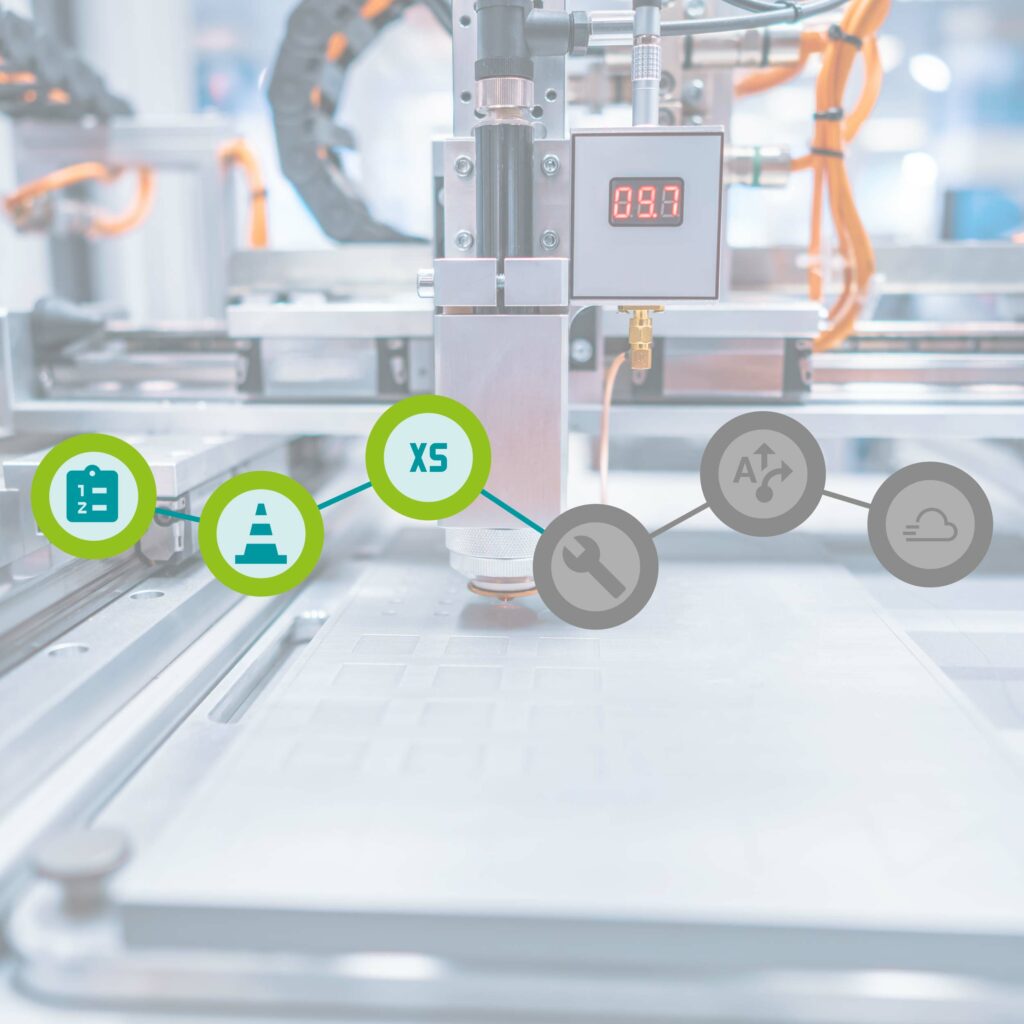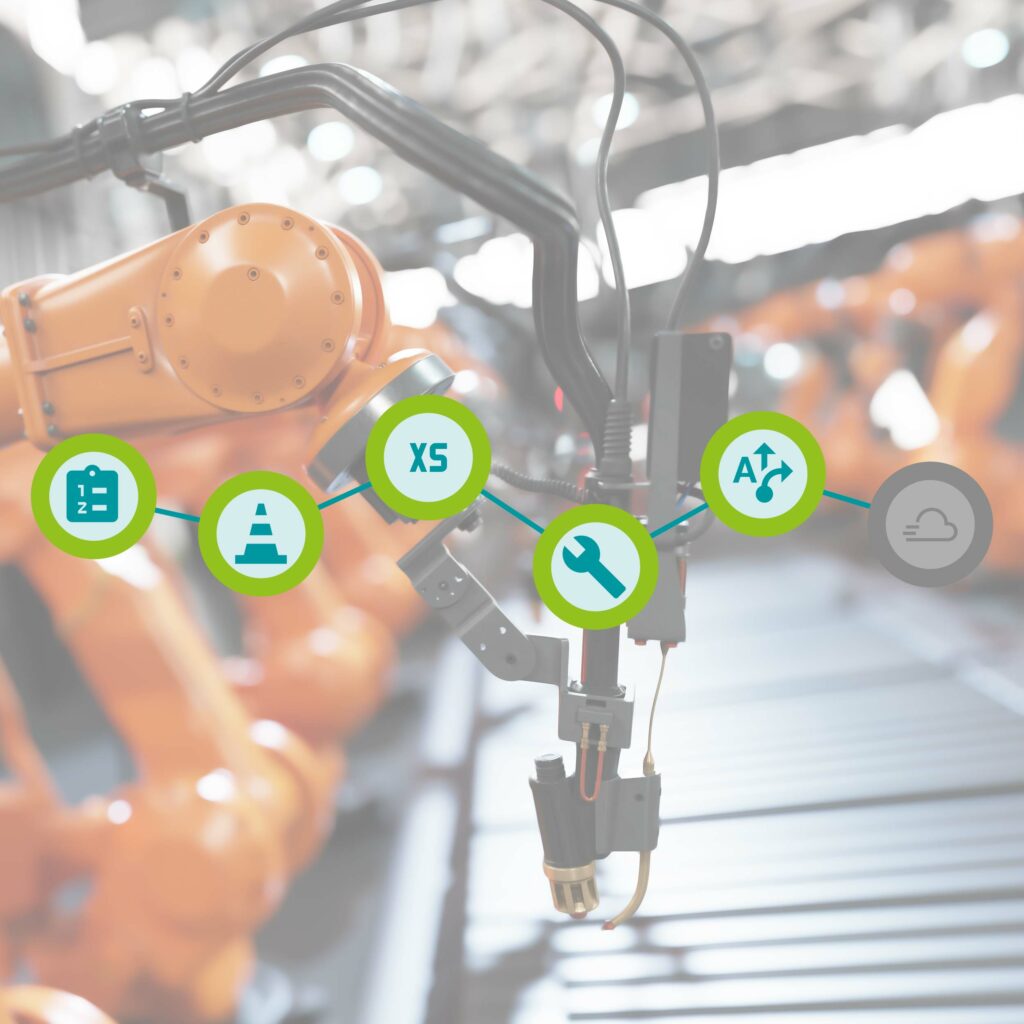
How SMEs can get started with IIoT: A Roadmap
Faster processes. Lower costs in production. Optimization of operational efficiency.
These are the benefits of the Industrial Internet of Things (IIoT). At the same time, new challenges arise. Collecting and monitoring data of hundreds of machines can quickly become confusing and complex. Often, it is small and medium-sized companies (SME) that hesitate to get started with IIoT because they lack resources and knowledge.
In this blog post, you will learn what you need to consider when implementing IIoT. Using a practical example, we will show you how to approach the complexity of the topic. In particular, a roadmap for SMEs is discussed.

Define your goals
Before you start implementing IIoT, you should ask yourself what you want to achieve. Collecting and connecting data from your machines will indeed provide you with results. But do those results add value to your business and processes? Analyze your current prevailing problems. Based on this, you can determine which data is needed from which machine. You can also use the results to estimate the IIoT implementation effort.
Goals may look like this:
- Optimization of configuration
- Savings of energy and raw materials
- Product quality improvement
- Optimization of maintenance prediction
We recommend that SMEs start with a goal that delivers the greatest value at an acceptable cost.

Avoid factors that can cause the project to fail
As in all business matters, your goals must be realistic. Many IIoT projects fail because the vision was too ambitious. The costs get out of hand. Too late it becomes apparent that the implementation was never feasible.
One reason for excessively high costs can be, for example, the wrong choice of technology. An investment in hardware and software that either does not meet your requirements or is far too powerful for your needs, costs you not only money, but also time and nerves.
Ideally, you should analyze your technical requirements and find an IIoT solution that allows you to test your first use case at low costs.
Many SMEs lack an expert team of data analysts that visualize data or prepare data-driven decisions. While this presents a challenge, it does not prevent a successful IIoT implementation. The next section explains why.

Get started with IIoT implementation on a small scale
After you have determined the goal and estimated the implementation effort, you can now take two paths:
- You appoint a data manager who coordinates and implements the project for all departments.
- You start with a test on a small scale.
We recommend the second path for SMEs. With this approach, you select a department that connects its machines and analyzes data on its own initiative. Once the team has gained enough experience, it scales the number of metrics and incorporates new measurement data for evaluation. In this way, a small test can develop into a bigger vision over time.

Choose the right tools
An IIoT environment requires both hardware and software to connect your machines efficiently. For example, the necessary components for the initial test project may include the following:
- programmable Logic Controllers (PLCs)
- gateways
- energy meters
A gateway can connect your existing hardware devices to link systems and transmit data.
In addition to these components, you need to consider whether you have sufficient IT expertise and resources to connect and monitor the machines.
We recommend the use of an Industrial IoT cloud solution since small and medium-sized companies usually do not have their own infrastructure or IT team for IIoT. All data from the machines then migrates to this cloud and can be monitored there.

Example: Maintenance optimization through time series data
So, which use case is suitable to get started with IIoT? You could begin with collecting and monitoring time series data to optimize the machine maintenance process.
The data
Time series data is a sorted collection of data that is generated at any company that operates machines. This includes, for example:
- motor temperatures
- RPMs
- flow rates
- energy consumption
- scrap rates
The data is determined at regular intervals. All measured data also has individual limit values. For example, the temperature of a servo should be a maximum of 90 °C.
The goal
Based on the limit values of the time series data, you can now optimize the maintenance work of the machines. The goal is to be alerted immediately in case of problems.
The solution approach that is scalable
The time series data of the machine is transmitted to a central location. Thanks to the recommended cloud approach, you can monitor data from anywhere. At the same time, an alerting function is set up on different channels, for example via e-mail. What does this mean?
A notification is sent to the service worker as soon as a limit value of the recorded time series data is exceeded. They can leave immediately to fix the problem.
Instead of just reacting, a proactive approach can also be developed from this IIoT implementation:
You can get started with predictive maintenance as data analytics make operations and maintenance more predictable. In addition, you can optimize your workflows over time since the central data collection allows you to compare (identical) machines and production sites.

Implement IIoT with Proficloud.io and Smart Services!
If you are an SME and plan to implement your first IIoT project, you can turn to full-service providers such as Phoenix Contact. Phoenix Contact provides you with necessary components such as PLCs, gateways and energy meters. You can also integrate other third-party devices. Apart from this, they offer a data analysis cloud where machine data is collected.
For example: Smart hardware devices connect to the Industrial IoT platform Proficloud.io. Using standardized and scalable Smart Services, machine data is collected, monitored, and tracked in the cloud. This means that you can access the data via a central portal and set up alerting functions adapted to the respective applications. Optimizing the maintenance process based on time series data is thus possible without complex system integration! Learn more about our Time Series Data Service to see how machine data is visualized.
Good to know: GDPR-compliant servers in Frankfurt and TLS encryption between Proficloud.io and the companies guarantee data protection and data security. Proficloud.io is certified by the VDE Institute according to the highest requirements and you always retain data sovereignty.
Summary: IIoT implementation roadmap
- Define your goals
- Choose the goal with the highest value at an acceptable effort
- Analyze the technical requirements
- Get technology that meets your requirements
- Start with a test on a small scale
- Scale the small test environment step by step
Conclusion
With IIoT, manufacturing companies can optimize their efficiency, speed up processes and reduce production costs. But they also must cope with a great deal of complexity, mainly due to the large amount of data and the frequent lack of skilled personnel.
To get the benefits of IIoT as an SME, focus on data projects that generate real value at a manageable cost. Start on a small scale to approach the topic of IIoT and grow with the experience you gain. The plug-and-play IIoT platform Proficloud.io allows you to easily connect your devices to a cloud infrastructure even without in-house IT resources. If you want to test the platform, just create a free Proficloud.io-account. Of course, you can always contact us if there are any questions!
Get in touch with us!
Are you interested in Smart Services Powered by Proficloud.io? Please do not hesitate to contact us. Also, if you have any suggestions or comments, just send us a message to inbox[at]phoenixcontact-sb.io and we will answer as soon as possible.

